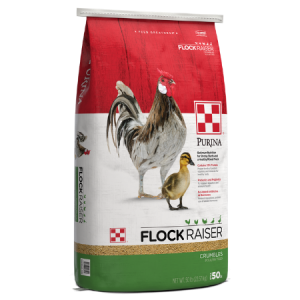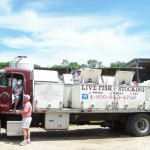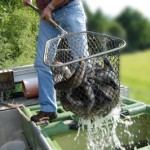Purina Flock Raiser Crumbles
 Purina Flock Raiser Crumbles provide optimum nutrition for healthy mixed poultry flocks. Formulated with prebiotics and probiotics to support optimum digestive health and immune function. This is a versatile 20%-protein nutrient-rich ration that provides nutrition for the following situations: the small crumbled format makes this feed perfect for starting baby birds, feeding a mixed flock that may include hens and roosters, turkeys, pheasants, guinea fowl and peafowl, help laying hens through molt or in times when feathering needs some extra support. Also available as a medicated feed with Amprolium (a coccidiostat).
Purina Flock Raiser Crumbles provide optimum nutrition for healthy mixed poultry flocks. Formulated with prebiotics and probiotics to support optimum digestive health and immune function. This is a versatile 20%-protein nutrient-rich ration that provides nutrition for the following situations: the small crumbled format makes this feed perfect for starting baby birds, feeding a mixed flock that may include hens and roosters, turkeys, pheasants, guinea fowl and peafowl, help laying hens through molt or in times when feathering needs some extra support. Also available as a medicated feed with Amprolium (a coccidiostat).
Have questions? Reach out to our friendly staff at any of our local Farmers Co-op locations. Also, be sure to follow us on Facebook for product updates, news and events.
Guaranteed Analysis
Nutrient Min / Max Amount
Crude Protein MIN 20.00 %
Lysine MIN 1.10 %
Crude Fat MIN 3.50 %
Crude Fiber MAX 5.00 %
Calcium (Ca) MIN0.80 %
Calcium (Ca) MAX 1.30 %
Phosphorus (P) MIN 0.60 %
Vitamin A MIN 7000 IU/LB
Vitamin E MIN 14 IU/LB
Methionine MIN 0.55 %
Salt (NaCl) MIN 0.30 %
Salt (NaCl) MAX 0.80 %
Phytase (A. Oryzae) MIN 227 FYT/lb
Feeding
Best Results
- Feed Purina Flock Raiser as the sole ration to chickens, ducks and geese from hatch until laying age (about 18-24 weeks; see number 3 below).
- For turkeys, first feed Purina Game Bird Chow Startena as the sole ration from hatch until 8-10 weeks old. Then feed them Purina Flock Raiser® until laying age (about 30-32 weeks).
- At 18-20 weeks of age, feed Purina Layena free-choice to laying chickens; ducks will begin laying at 20 to 24 weeks of age and geese will begin laying the spring after they are born.
- Always provide shelter and a constant supply of fresh, clean water.
- Consumption will vary depending upon season of the year, nutritional needs of the animals and availability of other foods.
Caution Store in a dry, well-ventilated area free from rodents and insects. Never use moldy or insect-infested feed.
Important A feeding program is only as effective as the management practices. Actual results can vary depending upon feed intake, environmental conditions and the quality of management practices


